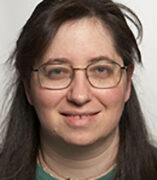
Avia Rosenhouse-Dantsker
Clinical Associate Professor
Contact
Address:
4236 SES
Office Phone:
Email:
Related Sites:
About
My research is focused on structural and functional mechanisms of protein modulation, with a special emphasis on the modulation of ion channels by lipids (e.g. cholesterol, phosphoinositides, and others). My work combines experimental and computational approaches. Among recent studies are the exciting discoveries that both atrial and hippocampal G protein-gated inwardly rectifying potassium channels are upregulated by cholesterol, and that cholesterol and PI(4,5)P2 act synergistically to activate these channels.
I teach courses in general and analytical chemistry, a course for non-science majors pertaining to the applications of chemistry in everyday life, and a graduate course on researching and writing for chemistry and biochemistry journals. I have also taught courses in physical and quantum chemistry, and lectured in a graduate course on ion channels.
Selected Publications
A. Slayden, K. North, S. Bisen, A.M. Dopico, A.N. Bukiya, and A. Rosenhouse-Dantsker. Enrichment of Mammalian Tissues and Xenopus Oocytes with Cholesterol. J. Vis. Exp. (157), 10.3791/60734 (2020).
A.N. Bukiya, Paul S. Blank, and A. Rosenhouse-Dantsker. Cholesterol intake and statin use regulate neuronal G protein-gated inwardly rectifying potassium channels. J. Lipid Res. 60, 19-29 (2019). [Featured by the American Society of Biochemistry and Molecular Biology in ASBMB Today (March 2019)]
A.N. Bukiya and A. Rosenhouse-Dantsker. Synergistic activation of G protein-gated inwardly rectifying potassium channels by cholesterol and PI(4,5)P2. Biochim. Biophys. Acta Biomembr. 1859, 1233-1241 (2017).
A.N. Bukiya, S. Durdagi, S. Noskov, and A. Rosenhouse-Dantsker. Cholesterol up-regulates neuronal G protein-gated inwardly rectifying potassium (GIRK) channel activity in the hippocampus. J. Biol. Chem. 292, 6135-6147 (2017). [Featured in a special virtual issue of J. Biol. Chem. (July 2017) of ion channel papers representing exciting advances in the field: http://www.jbc.org/site/vi/]
A.N. Bukiya, C.V. Osborn, G. Kuntamallappanavar, P.T. Toth, L. Baki, G. Kowalsky, M.J. Oh, A.M. Dopico, I. Levitan, and A. Rosenhouse-Dantsker. Cholesterol increases the open probability of cardiac KACh currents. Biochim. Biophys. Acta Biomembr. 1848, 2406-2413 (2015).
A. Rosenhouse-Dantsker, S. Noskov, S. Durdagi, D.E. Logothetis, and I. Levitan, “Identification of novel cholesterol-binding regions in Kir2 channels”, J. Biol. Chem. 288, 31154-31164 (2013).
A.A. Rodríguez-Menchaca, S.K. Adney, Q.-Y. Tang, X.-Y. Meng, A. Rosenhouse-Dantsker, M. Cui, and D.E Logothetis. PIP2 controls voltage sensor movement and pore opening of Kv channels through the S4-S5 linker. Proc. Natl. Acad. Sci. USA 109, E2399-2408 (2012).
W. Deng, A.N. Bukiya, A.A. Rodríguez-Menchaca, Z. Zhang, C.M. Baumgarten, D.E. Logothetis, I. Levitan, and A. Rosenhouse-Dantsker. Hypercholesterolemia induces up-regulation of KACh cardiac currents via a mechanism independent of phosphatidylinositol 4,5-bisphosphate and Gbg. J. Biol. Chem. 287, 4925-4935 (2012).
Y. Epshtein, A. Chopra, A. Rosenhouse-Dantsker, G. Kowalsky, D.E. Logothetis and I. Levitan. Identification of a C-terminus domain critical for the sensitivity of Kir2.1 to cholesterol.Proc. Natl. Acad. Sci. USA 106, 8055-8060 (2009).
A. Rosenhouse-Dantsker, J.L. Sui, Q. Zhao, R. Rusinova, A.A. Rodríquez-Menchaca, Z. Zhang, and D.E. Logothetis. A sodium-mediated structural switch that controls the sensitivity of Kir channels to PtdIns(4,5)P2. Nature Chem. Biol. 4, 624-631 (2008).